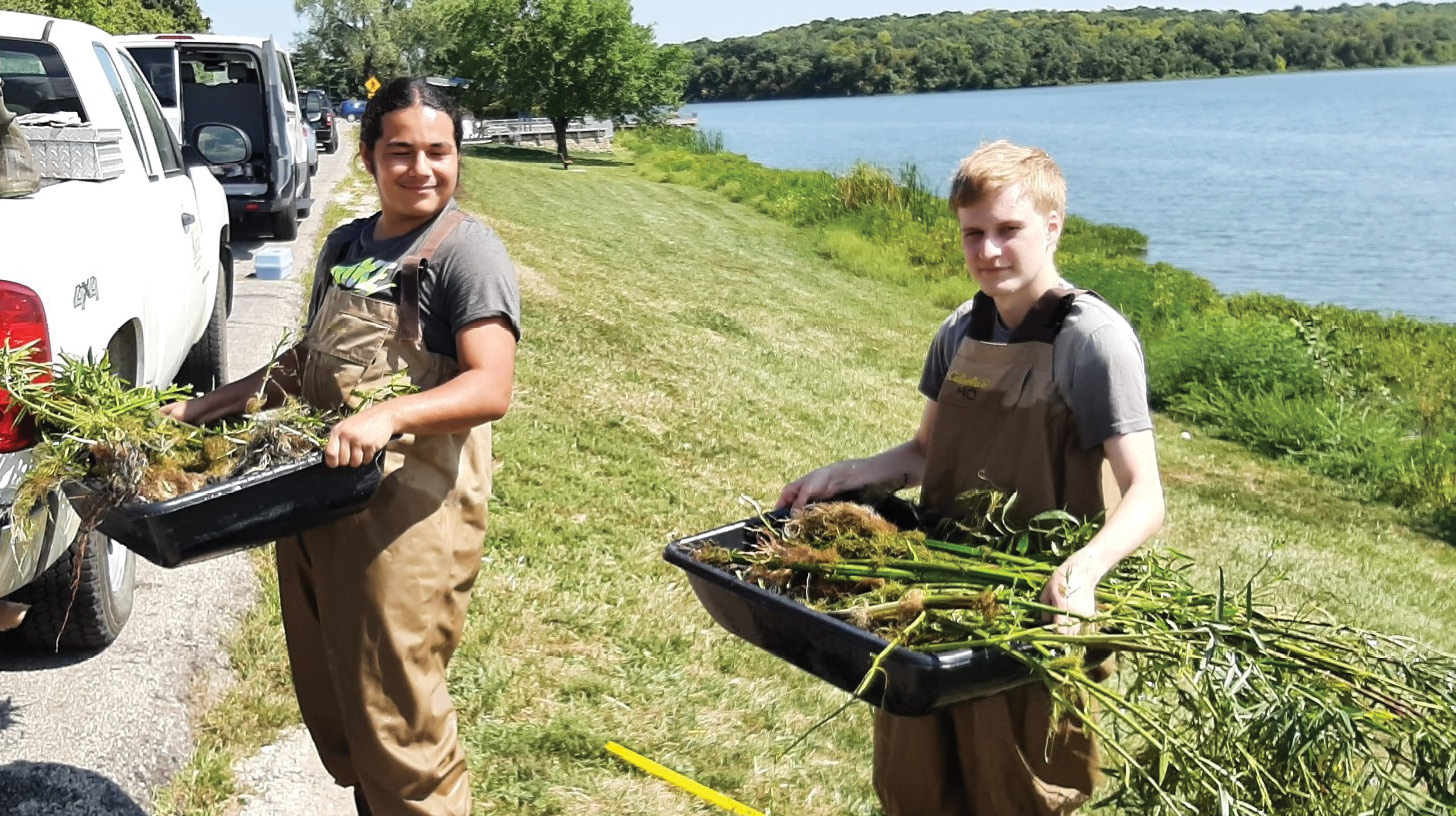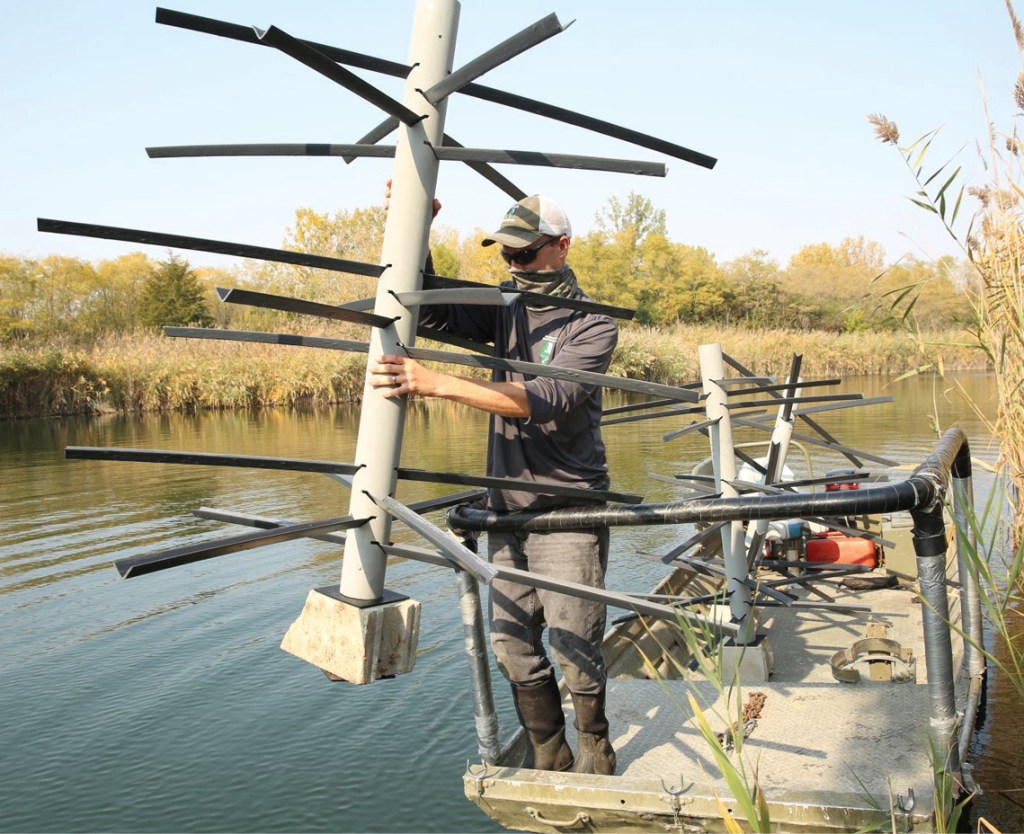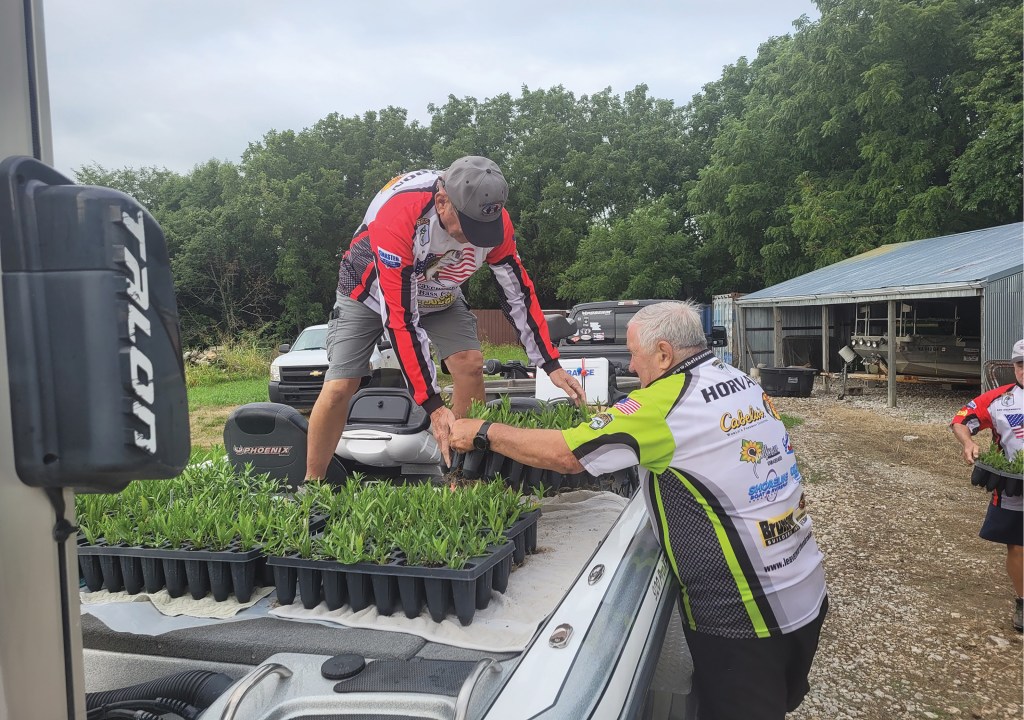
Whether it’s water willow in Kansas, eelgrass in Virginia or man-made habitat in the lakes of the Midwest, the fishing landscape across the country has improved due to the good work of AFTCO and the B.A.S.S. Nation.
Habitat is back at Kansas’ Hillsdale Reservoir thanks to a cooperative effort by the Leavenworth Bass Club and the Kansas Department of Wildlife and Parks (KDWP), with funding provided by a 2021 AFTCO x B.A.S.S. Nation Conservation Grant.
Sustained flooding in 2019 wiped out shoreline habitat on this 4,580-acre fishery.
“Historically, Hillsdale Reservoir had several arms, coves and shallow-water areas covered with vibrant stands of water willow, but the sustained flooding that occurred in 2019 wiped out all areas of shoreline habitat that the plant provided,” said Lucas Kowalewski, Kansas City District fisheries biologist.
But, using the AFTCO grant and funds from other sources, KDWP purchased 3,348 plants and then teamed with the Leavenworth Bass Club to plant them this past July.
Other 2021 grants financed B.A.S.S. Nation projects, often with youth involvement, to grow and plant eelgrass in Virginia’s Claytor Lake, add cypress trees to Kentucky’s Lake Barkley, place artificial structures in four Nebraska fisheries and enrich two Illinois lakes with spider blocks and other attractors.
The latter was expected to be completed this year, according to Jill Wijangco, Illinois B.A.S.S. Nation conservation director. Illinois Department of Natural Resources biologist Seth Love wrote the grant and “has been instrumental in this whole process and a wonderful asset,” she said.
Spider blocks, Shelbyville Cubes, cinder blocks and MossBack Safe Havens will be placed in Big Lake and Beaver Lake, two fisheries in Silver Springs State Fish and Wildlife Area in Kendall County. Both feature steep dropoffs and clear water and receive substantial fishing pressure.

“Due to the lack of habitat, fish are usually oriented near the few brushpiles present and the multiple water willow stands. Consequently, increasing the amount of cover would be extremely beneficial to these lakes,” Wijangco said.
In Nebraska, meanwhile, work was completed on June 25, with about 170 artificial structures placed in four lakes, according to Jim Baumert, Nebraska B.A.S.S. Nation conservation director.
The project began in October, as Scotus Central Catholic Youth Bassmasters and the Boy Scouts teamed with Nebraska B.A.S.S. Nation and Nebraska Game and Parks Commission (NGPC) to install 35 structures in Sock Pond and 25 in Lake Esther, fisheries in Columbus. Using AFTCO bank bags, they also cleaned up the shorelines.
For the second phase in June, NGPC’s Phil Chvala again provided his boat as volunteers placed 50 structures each in Maskenthine Reservoir near Stanton and Maple Creek Reservoir near Leigh.
“I am very proud of the hard work and selflessness of all the volunteers,” Baumert said. “While we ran into some bumps with COVID-19 issues and difficulty getting materials, we persevered and greatly improved the future of these fisheries. The support of AFTCO, Nebraska B.A.S.S. Nation and NGPC was critical to this process.”
Down in Kentucky, the Kentucky B.A.S.S. Nation (KBN) and Calloway County High School bass fishing team partnered with Kentucky Department of Fish and Wildlife Resources (KDFWR) to plant 1,375 cypress trees during this past winter drawdown at Barkley, according to Kentucky B.A.S.S. Nation Conservation Director Karl Schreiber. Friends of Reservoirs assisted AFTCO with the financing for trees and supplies.
More plantings were planned for this winter.
Over in Virginia, AFTCO funds helped finance the growth of eelgrass at Pulaski County High School.
“Last year, we partnered with Joan [Blankenship, Virginia conservation director] through [Virginia B.A.S.S. Nation] and then fisheries biologists John Copeland and Brooke Carver, along with Claytor Lake State Park,” said agriculture teacher Carley Pavan-Ballard.
“We managed to grow several trays of native eelgrass that we later planted in Claytor,” she continued, adding that more grass is being grown this year.

“John and Brooke came out to the school to start the project and set up all of the pumps and heaters. They also brought the seeds to germinate.”
Blankenship added that she hopes Pulaski will be the permanent location for this project that began in 2015 and has had several homes, as well as funding from Friends of Reservoirs, Shimano, Friends of Claytor Lake and other sources, as well as AFTCO.
“This is an expensive project that requires ongoing funding and a lot of volunteers,” she said.
“My role has become coordination, fundraising and education. My intention is to be sure that the teacher knows more about the B.A.S.S. organization, conservation programs and the roles that fisheries biologists play in this program.”
Back in Kansas, meanwhile, biologist Kowalewski added that KDWP, B.A.S.S. Nation and area schools have decided to adopt the “grow your own” strategy as well for water willows, with funding provided by Aquatic Ecosystem Restoration Foundation and Aquatic Plant Management Society, as well as AFTCO. Gardner-Edgerton, Mill Valley, and Shawnee Mission Northwest schools now have facilities for growing wetland plants that the biologist hopes “can be harvested and transplanted into Kansas water bodies.
“This portion of the project took place over the school year 2021-2022 and we saw mixed results,” he added. “We learned a lot about what it took to sustain the plants, but we struggled to gain increased production. We are taking lessons learned and moving forward this upcoming school year with new methods that we think will increase production.
“We are still [too] in the early stages to determine how successful the plantings will be, but I am optimistic that we are on our way to getting some of these historical areas of great habitat re-established.”
When these five projects were selected for funding in August 2021, Seth Meyer, conservation and content coordinator at AFTCO, said, “These projects really focus on direct improvements to fisheries. Whether it be fish habitats or planting vegetation, these projects are set to increase the abundance of fish in the lakes, something we can all get behind.”
Additionally, AFTCO President Casey Shedd said, “With a long history of conservation-minded initiatives, AFTCO is always looking for opportunities to help provide direct fishery improvements and partnering with Gene Gilliland and B.A.S.S. made complete sense. Over the course of the last four years we have donated more than $60,000, including $20,000 this year alone.”





